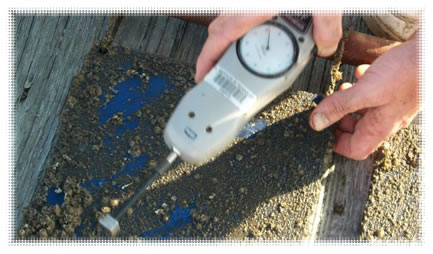This test method measures the shear strength of barnacles to a surface. It is used to establish the ability of a surface to reduce adhesion.
Apparatus
The apparatus required for this procedure includes a force gage to apply and measure shear force at the base of the barnacle, and a scanner plus software to measure the surface area of the barnacle base plate.

Procedure
Test surfaces that are exposed to static immersion are monitored for barnacle settlement. To facilitate adult barnacle growth on silicones with low fouling adhesion strengths, it has been found necessary to enclose the test area with a 25mm (1 inch) mesh net that excludes larger fish and other predators which would otherwise remove the immature forms. When settlement is observed, the shear strength of adhesion is measured as described below.
-
Barnacles between 5 - 20mm diameter are selected for testing and identified with regard to species and condition.
-
Only live barnacles which are at least 20mm from the edges of the test panel and not in direct contact with other barnacles should be tested.
-
A shear force is applied to the barnacle base using a hand held force measuring device at a rate of approximately 4.5N/s (1lb/s) until the barnacle becomes detached. The force is applied parallel to the surface.
-
The force required for detachment is noted, and observations are made as to the mode of failure. If more than 10% of the barnacle base plate is left attached to the substrate, the test is deemed void.
-
The barnacle is returned to the laboratory where the area of the base is measured using a scanner.
Calculation and Interpretation of Results

The strength of adhesion, pascals (psi), is calculated by dividing the force required to remove the barnacle, F newtons (pounds), by the area of the barnacle base plate, A square meters (square inches).
For each test surface the mean and standard deviation of the strength of adhesion is calculated. This is compared to typical shear adhesion strengths of Balanus eburneus to different substrates.

